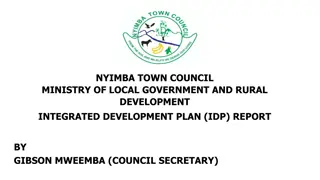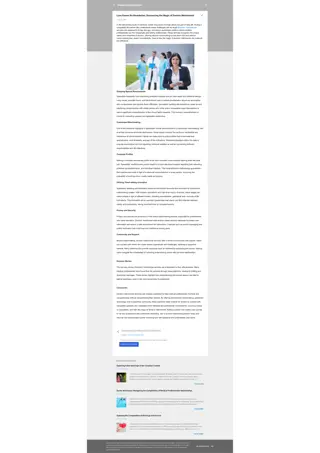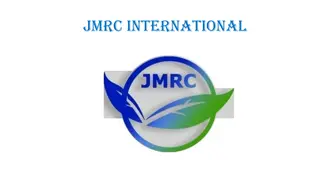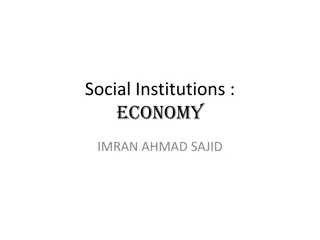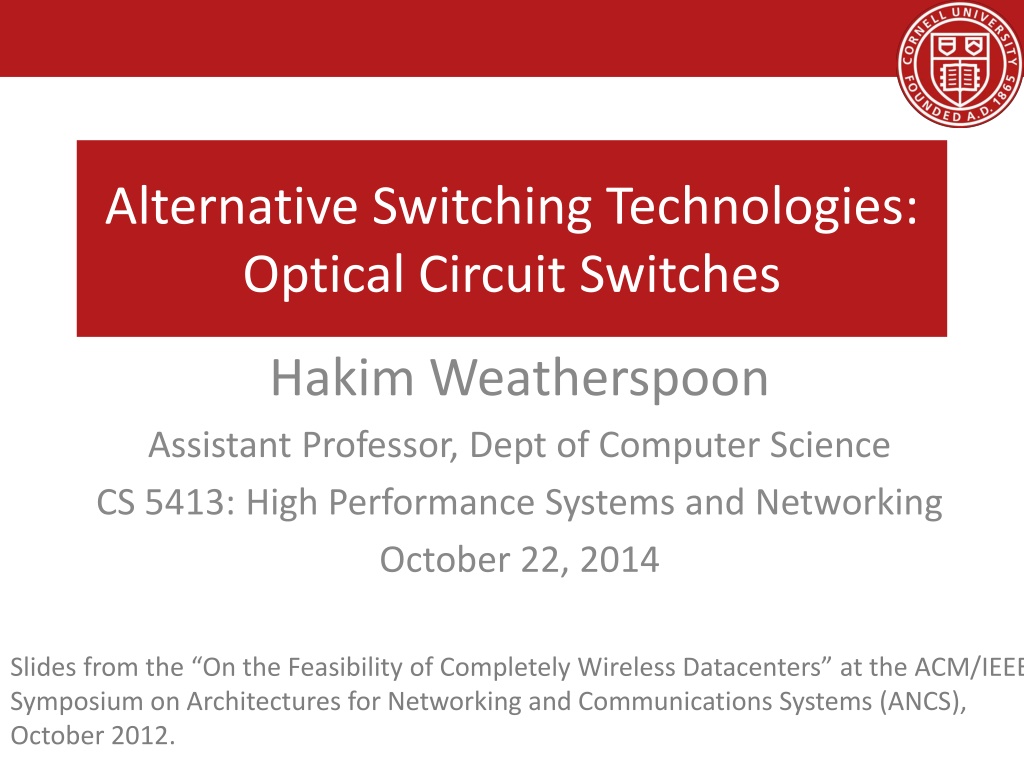
Optical Circuit Switching Technologies for Data Centers
Explore the feasibility of implementing completely wireless data centers using optical circuit switches, comparing them with traditional electrical packet switching technologies. Learn about hybrid packet/circuit switched networks and the advantages of optical circuit switching in terms of switching capacity and time efficiency. Discover the potential of wavelength division multiplexing and the innovative technology behind optical circuit switches.
Download Presentation

Please find below an Image/Link to download the presentation.
The content on the website is provided AS IS for your information and personal use only. It may not be sold, licensed, or shared on other websites without obtaining consent from the author. If you encounter any issues during the download, it is possible that the publisher has removed the file from their server.
You are allowed to download the files provided on this website for personal or commercial use, subject to the condition that they are used lawfully. All files are the property of their respective owners.
The content on the website is provided AS IS for your information and personal use only. It may not be sold, licensed, or shared on other websites without obtaining consent from the author.
E N D
Presentation Transcript
Alternative Switching Technologies: Optical Circuit Switches Hakim Weatherspoon Assistant Professor, Dept of Computer Science CS 5413: High Performance Systems and Networking October 22, 2014 Slides from the On the Feasibility of Completely Wireless Datacenters at the ACM/IEEE Symposium on Architectures for Networking and Communications Systems (ANCS), October 2012.
Goals for Today On the Feasibility of Completely Wireless Datacenters J. Y. Shin, E. G. Sirer, H. Weatherspoon, and D. Kirovski, IEEE/ACM Transactions on Networking (ToN), Volume 21, Issue 5 (October 2013), pages 1666-1680.
Current solutions for increasing data center network bandwidth BCube FatTree 1. Hard to construct 2. Hard to expand 4
An alternative: hybrid packet/circuit switched data center network Goal of this work: Feasibility: software design that enables efficient use of optical circuits Applicability: application performance over a hybrid network 5
Optical circuit switching v.s. Electrical packet switching Electrical packet switching Store and forward Optical circuit switching Circuit switching Switching technology Switching capacity Switching time 16x40Gbps at high end e.g. Cisco CRS-1 320x100Gbps on market, e.g. Calient FiberConnect Packet granularity Less than 10ms e.g. MEMS optical switch 6
Technology: Optical Circuit Switch Output 1 Output 2 Fixed Mirror Lenses Input 1 Glass Fiber Bundle 1. 2. 3. Full crossbar switch Does not decode packets Needs external scheduler Rotate Mirror Mirrors on Motors 2010-09-02 SIGCOMM Nathan Farrington 7
Wavelength Division Multiplexing Optical Circuit Switch No Transceivers Required Superlink 80G WDM MUX WDM DEMUX 10G WDM Optical Transceivers 1 2 3 4 5 6 7 8 Electrical Packet Switch 2010-09-02 SIGCOMM Nathan Farrington 8
Optical circuit switching is promising despite slow switching time [IMC09][HotNets09]: Only a few ToRs are hot and most their traffic goes to a few other ToRs. [WREN09]: we find that traffic at the five edge switches exhibit an ON/OFF pattern Full bisection bandwidth at packet granularity may not be necessary 9
Hybrid packet/circuit switched network architecture Electrical packet-switched network for low latency delivery Optical circuit-switched network for high capacity transfer Optical paths are provisioned rack-to-rack A simple and cost-effective choice Aggregate traffic on per-rack basis to better utilize optical circuits
Design requirements Traffic demands Control plane: Traffic demand estimation Optical circuit configuration Data plane: Dynamic traffic de-multiplexing Optimizing circuit utilization (optional) 11
c-Through (a specific design) No modification to applications and switches Leverage end- hosts for traffic management Centralized control for circuit configuration 12
c-Through - traffic demand estimation and traffic batching Applications Per-rack traffic demand vector Socket buffers 1. Transparent to applications. 2. Packets are buffered per-flow to avoid HOL blocking. Accomplish two requirements: Traffic demand estimation Pre-batch data to improve optical circuit utilization 13
c-Through - optical circuit configuration configuration Traffic demand Controller configuration Use Edmonds algorithm to compute optimal configuration Many ways to reduce the control traffic overhead 14
c-Through - traffic de-multiplexing VLAN #1 VLAN-based network isolation: No need to modify switches Avoid the instability caused by circuit reconfiguration VLAN #2 circuit configuration traffic Traffic control on hosts: Controller informs hosts about the circuit configuration Traffic de-multiplexer End-hosts tag packets accordingly VLAN #1 VLAN #2 15
Testbed setup 16 servers with 1Gbps NICs Emulate a hybrid network on 48-port Ethernet switch Ethernet switch 100Mbps links 4Gbps links Optical circuit emulation Optical paths are available only when hosts are notified During reconfiguration, no host can use optical paths 10 ms reconfiguration delay Emulated optical circuit switch 16
Evaluation Basic system performance: Can TCP exploit dynamic bandwidth quickly? Yes Does traffic control on servers bring significant overhead? No Does buffering unfairly increase delay of small flows? No Application performance: Bulk transfer (VM migration)? Yes Loosely synchronized all-to-all communication (MapReduce)? Yes Yes Tightly synchronized all-to-all communication (MPI-FFT) ? 17
TCP can exploit dynamic bandwidth quickly Throughput ramps up within 10 ms Throughput stabilizes within 100ms 18
MapReduce Overview local write data shuffling load write output file mapper reducer Input file Split 0 Split 1 Split 2 output file mapper reducer output file mapper reducer Concentrated traffic in 64MB blocks Concentrated traffic in 64MB blocks Independent transfers: amenable to batching 19
MapReduce sort 10GB random data 900 800 Completion time (s) 700 600 500 400 153s 300 135s 200 100 0 Electrical network 128 KB 50 MB 100 MB 300 MB 500 MB Full bisection bandwidth c-Through c-Through varying socket buffer size limit (reconfiguration interval: 1 sec) 20
MapReduce sort 10GB random data 900 Completion time (s) 800 700 600 500 400 168s 135s 300 200 100 0 0.3 Sec 0.5 Sec 1.0 Sec 3.0 Sec 5.0 Sec Full bisection bandwidth Electrical network c-Through c-Through varying reconfiguration interval (socket buffer size limit: 100MB) 21
Yahoo Gridmix benchmark 3 runs of 100 mixed jobs such as web query, web scan and sorting 200GB of uncompressed data, 50 GB of compressed data 22
Summary Hybrid packet/circuit switched data center network c-Through demonstrates its feasibility Good performance even for applications with all to all traffic Future directions to explore: The scaling property of hybrid data center networks Making applications circuit aware Power efficient data centers with optical circuits 23 Picture from Internet websites.
Related Work Link Technology Modifications Required Working Prototype Optics w/ WDM 10G-180G (CWDM) 10G-400G (DWDM) Switch Software Glimmerglass, Fulcrum Helios (SIGCOMM 10) Optics (10G) Host OS Emulation c-Through (SIGCOMM 10) Wireless (1G, 10m) Unspecified Flyways (SIGCOMM 11, HotNets 09) Optics (10G) Host Application; Specific to Stream Processing Calient, Nortel IBM System-S (GLOBECOM 09) Optics (10G) Host NIC Hardware HPC (SC 05)
Before Next time Project Interim report Due Monday, October 27. And meet with groups, TA, and professor Lab3 Packet filter/sniffer Due tomorrow, Tuesday, October 21. Lab1/2 redux due Friday, October 24 Fractus Upgrade: SAVE ALL YOUR DATA Fractus will be upgraded from October 28th to 30th Can use Red Cloud during upgrade period, then switch back to Fractus Required review and reading for Wednesday, October 22 On the Feasibility of Completely Wireless Datacenters, J. Y. Shin, E. G. Sirer, H. Weatherspoon, and D. Kirovski, IEEE/ACM Transactions on Networking (ToN), Volume 21, Issue 5 (October 2013), pages 1666-1680. Check piazza: http://piazza.com/cornell/fall2014/cs5413 Check website for updated schedule

![[PDF⚡READ❤ONLINE] In Ruins: A Journey Through History, Art, and Literature](/thumb/20543/pdf-read-online-in-ruins-a-journey-through-history-art-and-literature.jpg)






